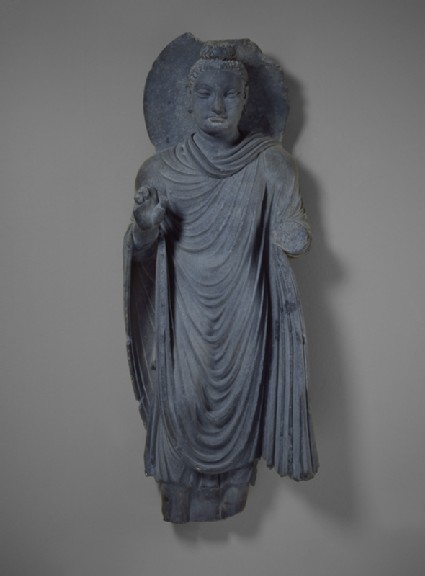Room 12 | India 2500 BC-AD 600 gallery
Explore the early development of Indian art, from the artefacts of the Indus Valley to the Hindu and Buddhist sculpture of north India and Gandhara.

Galleries : 31 objects
Show search help- Reference URL
Actions
Standing figure of the Buddha Sakyamuni
-
Description
In a classic standing pose, the Buddha raises his right hand in the fear-dispelling gesture; his left hand would have held the folds of his monk’s robe. The finely carved head and the modelling of the robe show strong Greco-Roman influences.
-
Details
- Associated place
- Date
-
late 2nd century - early 3rd century AD
Kushan Period (AD 50 - 600)
- Associated people
-
the Buddha (active c. 560 BC - c. 486 BC) (subject)
- Material and technique
- grey schist
- Dimensions
- 95 x 37 x 16 cm max. (height x width x depth)
- Material index
- Technique index
- Object type index
- No. of items
- 1
- Credit line
- Presented by Miss Barlow, 1913.
- Accession no.
- EAOS.26
-
Further reading
Harle, J. C., and Andrew Topsfield, Indian Art in the Ashmolean Museum (Oxford: Ashmolean Museum, 1987), no. 15 on p. 13, pp. 11 & 14, illus. p. 13
Penny, Nicholas, The Materials of Sculpture (New Haven: Yale University Press, 1993), illus. p. 103 fig. 94
Heller, Amy, Early Himalayan Art (Oxford: Ashmolean Museum, 2008), p. 14, illus. p. 14 fig. 2
Oxford: Ashmolean Museum, 24 May 2006-23 December 2008, Treasures: Antiquities, Eastern Art, Coins, and Casts: Exhibition Guide, Rune Frederiksen, ed. (Oxford: Ashmolean Museum, 2006), no. 174 on p. 62, illus. p. 62
Location
Objects are sometimes moved to a different location. Our object location data is usually updated on a monthly basis. Contact the Jameel Study Centre if you are planning to visit the museum to see a particular object on display, or would like to arrange an appointment to see an object in our reserve collections.
Publications online
-

-

Indian Art in the Ashmolean Museum
Buddhism flourished in India for more than a thousand years after the Buddha’s death (c.480 B.C.). and Buddhist monuments have survived from as early as the third century and second century B.C. long before the first images of the Buddha were made. On reliefs he was represented, if at all, by symbols, his turban, his footprints, his begging bowl [see EAOS. 24]. It was only in the first or second centuries A.D., probably due to doctrinal changes, that the first Buddhas were carved, in the rounded relief. This probably happened first at Mathura, but if so Gandhara followed shortly. Stylistically, however, the earliest Buddhas from Gandhara are worlds apart from those from Mathura. Whilst the latter are in an Indian idiom. Gandhara Buddhas, while predominantly Indian in iconography, reflect classical Greco-Roman art to an extraordinary degree. An eminent authority has even gone so far as to see the art of Gandhara as a provincial Roman art in the service of Buddhism.
The Buddha’s iconography is here fully developed. A large mole in the centre of his forehead, just above the nose, becomes known as one of the Buddha’s characteristics. So does what appears to be a protuberance on the top of his head; the usnīsa, as it is called, is in reality a chingnon or bun, a reminder that the Buddha came from the equivalent of the warrior caste, whose members did not cut their hair, wearing it in a bun under their turbans. The Buddhe, however, has cast off his turban, as well as his jewellery. The extended ear-lobes, again, testify to his formerly having worn heavy ear-rings [see EAOS.24]. These features gave rise to one authority's dictum, that the Buddha is shown as a prince without ornaments and at the same time a monk without a shaven head.
Since hundreds, if not thousands, of these images were carved by the industrious stonr carvers of Gandhara, the larger ones placed in the chapels of monasteries, it is thus easy to reconstitute the gestures of the missing hands: the righ in the ritual gesture (mudrā) of abhaya, the left holding the folds of his saṃghaṭī. This is not the Roman toga, as was at one time assumed, but the upper garment of the Buddhist monks. Its plastic nature, however, with the folds of the garment lovingly treated for their own sake and completely masking the contours of the body, is totally in the Roman manner; equally classical is the treatment of the Buddha's head, ultimately based on that of the Greek Apollo.
The almond shaped eyes of this Buddha suggest a date a century or two later than that of the earliest Gandhara Buddhas, whose heads were more naturalistically treated and were often adorned with moustaches. The halo is of Middle Eastern origin.
Galleries
Notice
Objects may have since been removed or replaced from a gallery. Click into an individual object record to confirm whether or not an object is currently on display. Our object location data is usually updated on a monthly basis, so contact the Jameel Study Centre if you are planning to visit the museum to see a particular Eastern Art object.
© 2013 University of Oxford - Ashmolean Museum




